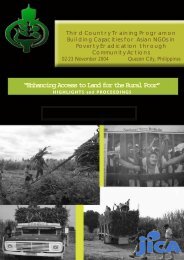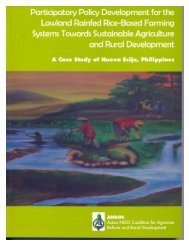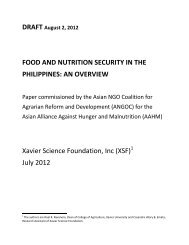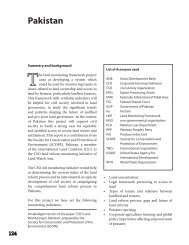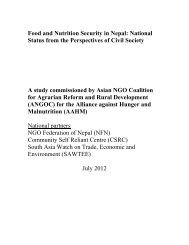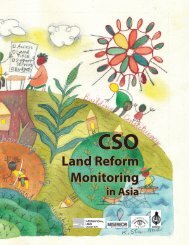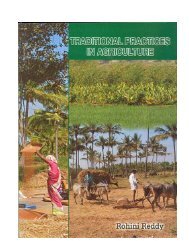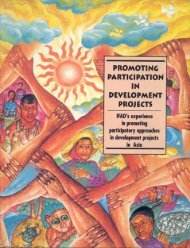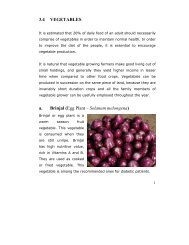Securing the Right to Land FULL - ANGOC
Securing the Right to Land FULL - ANGOC
Securing the Right to Land FULL - ANGOC
You also want an ePaper? Increase the reach of your titles
YUMPU automatically turns print PDFs into web optimized ePapers that Google loves.
SECURING THE RIGHT TO LAND140<br />
provinces reported that more than half of respondents do not have<br />
access <strong>to</strong> post-harvest facilities (e.g., thresher, drier, hauler, warehouse,<br />
etc.) and 44 % of <strong>the</strong> respondents had access <strong>to</strong> credit<br />
(just seven percent which was provided by <strong>the</strong> government).<br />
Exemptions from CARP Coverage<br />
The government’s original target of 10.3 million hectares in 1988<br />
was severely reduced in 1996 <strong>to</strong> 8.1 million hectares due <strong>to</strong><br />
exemptions and massive land conversion. More than 5.3 million<br />
hectares of land were exempted outright from CARP in 1996. The<br />
reduction in public land covered by CARP was due <strong>to</strong> <strong>the</strong> lease of<br />
vast tracts of government <strong>to</strong> cattle ranchers, opera<strong>to</strong>rs of export<br />
crop plantations, and logging concessionaires (SALIGAN, 2007)<br />
Insufficient Political Will<br />
The poor performance of CARP is due <strong>to</strong> lack of political will, as<br />
evidenced by government’s deliberate understatement of its targets;<br />
its inability <strong>to</strong> hold DAR accountable for its implementation<br />
of CARP; and inadequate funding for <strong>the</strong> CARP.<br />
DAR’s Poor Performance<br />
DAR’s poor performance is manifested in: (i) <strong>the</strong> predominance<br />
of VOS and VLT as <strong>the</strong> primary mode of land acquisition, as opposed<br />
<strong>to</strong> <strong>the</strong> much more difficult CA; (ii) <strong>the</strong> department’s orientation<br />
on quantity, which measures success in terms of<br />
number of hectares awarded; (iii) <strong>the</strong> absence of an effective<br />
moni<strong>to</strong>ring system <strong>to</strong> determine if <strong>the</strong> intended ARBs have actually<br />
been installed in <strong>the</strong> lands awarded <strong>the</strong>m; and (iv) high<br />
incidence of abandonment, sale, or mortgaging of CARPawarded<br />
lands by ARBs <strong>to</strong> raise money for medical expenses or<br />
because of <strong>the</strong> lack of credit for production.<br />
Market-oriented Tenurial Schemes<br />
DAR’s poor performance in <strong>the</strong> distribution of private agricultural<br />
lands is compounded by <strong>the</strong> promotion of various arrangements<br />
<strong>to</strong> circumvent actual land transfer <strong>to</strong> farmers. One such<br />
scheme is <strong>the</strong> “leaseback” arrangement whereby ARBs turn<br />
over control of <strong>the</strong> awarded land (via a lease contract) <strong>to</strong><br />
agribusiness corporations or <strong>to</strong> <strong>the</strong> former landowners as a precondition<br />
for <strong>the</strong> release of <strong>the</strong> ARB’s CLOAs (Certificate of <strong>Land</strong><br />
Ownership Award). Ano<strong>the</strong>r dubious arrangement is <strong>the</strong> “corporative”<br />
scheme, wherein ARBs are given shares of s<strong>to</strong>ck in<br />
<strong>the</strong> agricultural corporation of <strong>the</strong> landowner in lieu of having<br />
<strong>the</strong> land transferred <strong>to</strong> <strong>the</strong>m. Conversion of agricultural land <strong>to</strong><br />
commercial, residential and industrial uses is also prevalent,<br />
fur<strong>the</strong>r reducing <strong>the</strong> scope of land reform.<br />
Lack of Donor Support for <strong>Land</strong> Acquisition<br />
The policy of donor agencies <strong>to</strong> fund support services delivery<br />
(ra<strong>the</strong>r than <strong>the</strong> more controversial land acquisition) has also<br />
contributed <strong>to</strong> poor CARP implementation. Also donor funding<br />
for NGO activities related <strong>to</strong> agrarian reform has been reduced<br />
and shifted <strong>to</strong>ward government projects.<br />
<strong>Land</strong>lord Resistance<br />
<strong>Land</strong>lord resistance is one of <strong>the</strong> major bottlenecks in CARP<br />
implementation. This takes various forms, including not presenting<br />
<strong>the</strong> necessary documents; circumventing <strong>the</strong> CARP by<br />
exploiting legal loopholes; using connections <strong>to</strong> high-ranking<br />
government officials; and harassment of ARBs.<br />
Fac<strong>to</strong>rs Hindering Indigenous Peoples’ Access<br />
<strong>to</strong> <strong>the</strong>ir Ancestral Domains<br />
Snail-paced Ancestral Domain Titling<br />
Ten years after <strong>the</strong> passage of IPRA, only 20% of <strong>the</strong> targeted<br />
area (slightly more than half a million hectares of land) have<br />
been awarded <strong>to</strong> indigenous communities and very limited development<br />
activities in support of <strong>the</strong> Ancestral Domain Management<br />
Plans have been undertaken in IP areas. There are 181 ancestral<br />
domains, with a combined area of 2.54 million hectares, covered<br />
by CADCs.<br />
Mining Operations on IP lands<br />
Since 1992 <strong>the</strong> Philippine government has been aggressively<br />
promoting <strong>the</strong> revitalization of <strong>the</strong> mining industry, for which it<br />
has opened up 30% of <strong>the</strong> country’s land area <strong>to</strong> exploitation<br />
(Doyle, et al., 2007). In 2006, <strong>the</strong> DENR received 1,953 mining<br />
applications. According <strong>to</strong> <strong>the</strong> DENR, <strong>the</strong>re are 1,953 mining<br />
applications currently pending.<br />
Weak Implementing Agency<br />
NCIP, <strong>the</strong> agency mandated <strong>to</strong> implement IPRA, is ill-equipped,<br />
underfunded, staffed with people who are poorly trained and<br />
lack field experience and cultural sensitivity <strong>to</strong> handle land<br />
conflicts and issues of resource access. A number of NCIP personnel<br />
have been accused of helping mining companies gain<br />
entry in<strong>to</strong> IP lands by getting around <strong>the</strong> FPIC requirement.<br />
Lack of Effective Integration between NCIP and DAR<br />
In 2008, NCIP, which used <strong>to</strong> be under DAR, became an agency<br />
under DENR. This transfer gives cause for concern. DAR may<br />
not, as a result, be expected <strong>to</strong> prioritize or at least give due at-



